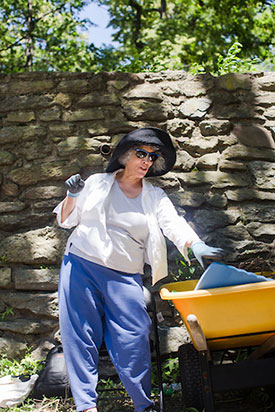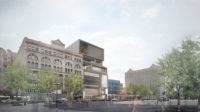On June 16 in New York City, multidisciplinary artist Maren Hassinger welcomed her 71st birthday with cake—and an installation of eight of her site-specific sculptures in the 20-acre Marcus Garvey Park. Titled “Maren Hassinger: Monuments,” the exhibition will be on view from June 16 to June 10, 2019, as part of an ongoing initiative by the Studio Museum, a contemporary museum devoted to African American art.
The exhibition is part of an initiative called “inHarlem,” which launched in 2016 and aims to both make art more accessible and strengthen the museum’s ties within the community while its new building, designed by Adjaye Associates in collaboration with Cooper Robertson, is under construction. Located on the site of its existing building renovated by the late African American architect J. Max Bond Jr., the new design will feature dark monolithic volumes and sculptural facades.
Until construction finishes in 2021, assistant curator Hallie Ringle says the museum is reaching out to bring art to the people. “We are thinking about what a museum does without walls,” says Ringle. “And so we’ve taken programming that would normally occur in our gallery and thought about how it exists in the community that we exist in.”
Organized in partnership with the Marcus Garvey Park Alliance and NYC Parks, the exhibition blocks away from the museum’s old building illustrates Hassinger’s interest in creating deep connections with the natural world and the surrounding landscape. “Her work makes you far more aware of your surroundings and how you exist as a person,” Ringle says.

The Harlem resident used six truckloads of branches from New York City parks to create the sculptures. Hassinger worked with Leong Leong designer Gabriel Burket to fabricate the large, various shaped metal frames that were then wrapped with chicken wire and filled with locally sourced wood chips. Finally, Hassinger and 75 community volunteers—whose names she read before cutting into her birthday cake—began the two week process of weaving the bundles of twigs onto the frames, securing them with zip ties. “A lot of people would walk by and ask, ‘What are you doing?’” Hassinger says, describing the installation process. “And when we told them, a smile would come to their face. Then they’d say, ‘Oh, can I help?’”
Each form responds to the world around it, becoming what Hassinger calls a monument to nature. One piece curves like a flowing river around the rocks at the south side of the park. Near a cluster of chess tables, branches form a great cube. Hassinger says each form’s desire to merge with its environment is its most powerful contribution to the landscape. “This precious land reminds us of our unity—our common cause on their earth,” the artist says. “We are citizens of this neighborhood, this city, this country, and this world, and we are all sprung from nature.”










